


Synthesis of potassium tetraperoxochromate(V), K3CrO8
Chromium usually is in the +6 oxidation state, +3 oxidation state and sometimes in the +2 oxidation state in its compounds. A fairly unknown compound exists, with chromium in the +5 oxidation state. This compound easily can be made. The chemicals, needed for this are potassium dichromate, potassium hydroxide and hydrogen peroxide. All three are commonly encountered in many labs, and it is quite special that a rather obscure compound can be made from these common chemicals relatively easily at good yield. This page gives a recipe, which can be used for succesfully making this chromium(V) compound. The compound is a peroxo compound, which best can be written as K3Cr(O2)4, but for brevity it simply is written as K3CrO8 further below.
![]() The compound, made in this experiment, is not a toy! Its toxicity is at least comparable
to that of potassium dichromate, and it explodes violently when it is heated.
Actually, it is rather nasty stuff, which must be handled with great care!
The compound, made in this experiment, is not a toy! Its toxicity is at least comparable
to that of potassium dichromate, and it explodes violently when it is heated.
Actually, it is rather nasty stuff, which must be handled with great care!
![]()
![]() Required
chemicals:
Required
chemicals:
-
potassium dichromate
-
potassium hydroxide
-
hydrogen peroxide (15%)
-
alcohol (96%)
-
diethyl ether (optional, if this is not used, then use high quality 96% alcohol, which is not denatured, or is denatured with completely volatile compounds only)
![]() Required
equipment:
Required
equipment:
-
some beakers or erlenmeyers
-
refrigerator or ice bath
![]() Safety:
Safety:
- Dichromates are toxic and also are carcinogenic. A solution of potassium dichromate is a skin sensitizer. Avoid any contact with the skin!
- Potassium hydroxide is very corrosive.
- Hydrogen peroxide at a concentration above 10% is quite corrosive. It gives white stinging stains at the skin, which disappear after a few minutes.
- The product compound, K3CrO8 is very toxic and probably even a stronger carcinogen than hexavalent chromium compounds. It also is a strong oxidizer which forms dangerously sensitive mixes with many reductors. Even without reductor it explodes when it is heated!
![]() Disposal:
Disposal:
- The waste from this experiment must be neutralized with a solution of sodium bisulfite in dilute hydrochloric acid, such that a green solution, containing chromium(III) only, is obtained. If the experiment is not scaled up, then the small amount of chromium(III) waste can be flushed down the drain with a lot of water. If one is scaling up considerably, then it is better to bring the chromium(III) waste to a proper waste processing facility.
![]()
The recipe
![]() Take 5 grams of potassium dichromate and 5 grams of potassium
hydroxide. This is an excess of potassium hydroxide, but one can better have
some excess, than too little. Sometimes, potassium hydroxide may contain as much
as 15% of water. If not sure about your potassium hydroxide, add 1 gram more.
Hydroxide deficiency is much more detrimental to yield than some excess. As long
as there is excess hydroxide, the amount is not critical at all.
Take 5 grams of potassium dichromate and 5 grams of potassium
hydroxide. This is an excess of potassium hydroxide, but one can better have
some excess, than too little. Sometimes, potassium hydroxide may contain as much
as 15% of water. If not sure about your potassium hydroxide, add 1 gram more.
Hydroxide deficiency is much more detrimental to yield than some excess. As long
as there is excess hydroxide, the amount is not critical at all.

![]() Prepare
40 ml of 15% solution of hydrogen peroxide by mixing 20 ml of 30% hydrogen
peroxide with 20 ml of water. Again, this is a fairly large excess, but as with
the hydroxide, having some excess hydrogen peroxide is not a problem at all.
Sometimes, the solution of hydrogen peroxide has deteriorated somewhat (e.g. it
is only 25% or even less). This recipe has a built in margin of approximately
20%.
Prepare
40 ml of 15% solution of hydrogen peroxide by mixing 20 ml of 30% hydrogen
peroxide with 20 ml of water. Again, this is a fairly large excess, but as with
the hydroxide, having some excess hydrogen peroxide is not a problem at all.
Sometimes, the solution of hydrogen peroxide has deteriorated somewhat (e.g. it
is only 25% or even less). This recipe has a built in margin of approximately
20%.
![]() Dissolve
the potassium dichromate and potassium hydroxide in some water. Add 20 ml of
cold distilled water and stir with a clean glass rod. The potassium hydroxide
quickly dissolves, the potassium dichromate dissolves more slowly, but finally
all of it will dissolve. With the glass rod, the larger pieces can be crunched.
Be careful while dissolving the solids. Quite some heat is produced when the
potassium hydroxide dissolves. The solution becomes warm.
Dissolve
the potassium dichromate and potassium hydroxide in some water. Add 20 ml of
cold distilled water and stir with a clean glass rod. The potassium hydroxide
quickly dissolves, the potassium dichromate dissolves more slowly, but finally
all of it will dissolve. With the glass rod, the larger pieces can be crunched.
Be careful while dissolving the solids. Quite some heat is produced when the
potassium hydroxide dissolves. The solution becomes warm.
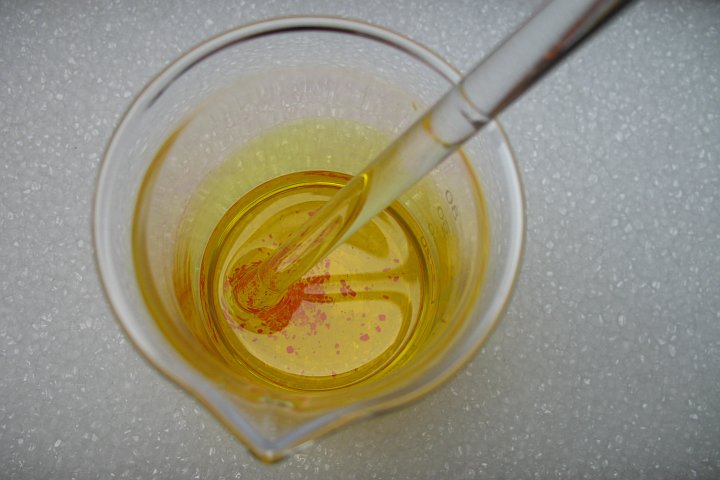
 When
all solid material has dissolved, add more water, such that the total volume is
approximately 30 ml. If the solution is somewhat turbid, also after completing
the volume to 30 ml, then the solution must be filtered. It is important that a
clean and clear solution is obtained. Finally, the solution must look as shown
in the picture at the left. The solution is deep yellow and clear. This is a
concentrated solution of potassium chromate, with excess potassium hydroxide in
solution.
When
all solid material has dissolved, add more water, such that the total volume is
approximately 30 ml. If the solution is somewhat turbid, also after completing
the volume to 30 ml, then the solution must be filtered. It is important that a
clean and clear solution is obtained. Finally, the solution must look as shown
in the picture at the left. The solution is deep yellow and clear. This is a
concentrated solution of potassium chromate, with excess potassium hydroxide in
solution.
At this point, there now are two solutions, one of them being the potassium chromate in excess potassium hydroxide, the other being the 15% hydrogen peroxide.
![]() Put both
solutions in a refrigerator, which must be really cold. The colder the
solutions, the better. A general refrigerator can reach temperatures below -15
ēC, this is quite good. If no refrigerator is available, then use an ice-cold
salt/ice mix for chilling the solutions. It really is important that the
solutions are ice-cold.
Put both
solutions in a refrigerator, which must be really cold. The colder the
solutions, the better. A general refrigerator can reach temperatures below -15
ēC, this is quite good. If no refrigerator is available, then use an ice-cold
salt/ice mix for chilling the solutions. It really is important that the
solutions are ice-cold.
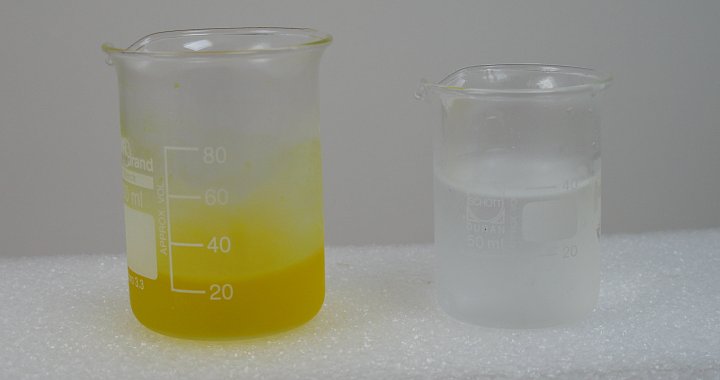
![]() When
both solutions are ice-cold, then take them out of the refrigerator and mix them
carefully, while stirring with a clean glass rod. When
a small amount of hydrogen peroxide is added, then one already sees a change of
color. The yellow solution turns red/brown.
When
both solutions are ice-cold, then take them out of the refrigerator and mix them
carefully, while stirring with a clean glass rod. When
a small amount of hydrogen peroxide is added, then one already sees a change of
color. The yellow solution turns red/brown.
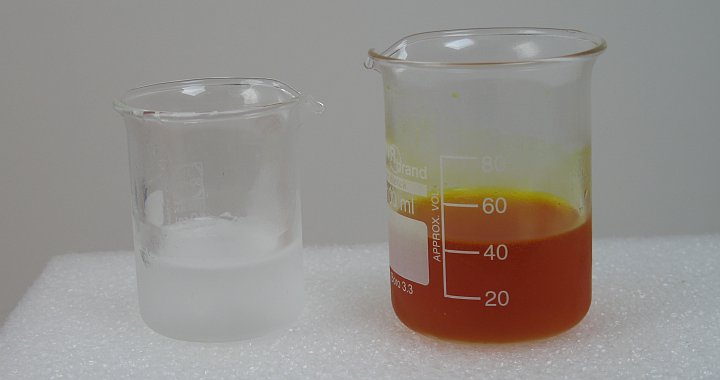
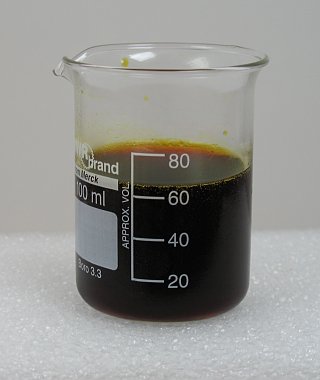 When
all of the hydrogen peroxide is added, then the solution almost becomes black.
There also is some bubbling. At this point it is
important to put the solution back into the refrigerator, or even better, into a
very cold ice-bath as quickly as possible. Cover the beaker with an inverted
petri-dish, before it is put in the refrigerator. It will continue
bubbling and little droplets are sprayed around and go into the air. These
droplets should not contaminate the refrigerator, keep in mind that hexavalent
chromium compounds are carcinogens and you don't want such contamination.
One can also use a bottle of 100 ml with a screw cap instead of a beaker as
shown in the picture. The cap should be loosely screwed on the neck of
the bottle. Quite some gas is produced and one definitely may not tightly close
the bottle. That certainly will lead to rupture, due to buildup of high
pressure. It also is important that the solution is not swirled. Swirling causes
excessive bubbling and may even lead to so much foam that the solution is going
over the rim of the bottle or beaker! Let the solution stand in the refrigerator
or an ice bath for two hours. Just leave it there, do not move it. Initially, it
is best to check the solution every few minutes, just to be sure that bubbling
does not become so fast, that foam goes over the rim of the beaker. If the
refrigerator is really cold, then this will not happen. On the other hand, one
also must be sure, that the liquid does not completely freeze. Check the liquid
every 20 minutes, especially after the first half hour. A little crust of ice at
the surface is not a problem. If the liquid indeed tends to freeze, then take
the beaker out of the refrigerator and let it stand at a cool place, preferably
close to 0 ēC.
When
all of the hydrogen peroxide is added, then the solution almost becomes black.
There also is some bubbling. At this point it is
important to put the solution back into the refrigerator, or even better, into a
very cold ice-bath as quickly as possible. Cover the beaker with an inverted
petri-dish, before it is put in the refrigerator. It will continue
bubbling and little droplets are sprayed around and go into the air. These
droplets should not contaminate the refrigerator, keep in mind that hexavalent
chromium compounds are carcinogens and you don't want such contamination.
One can also use a bottle of 100 ml with a screw cap instead of a beaker as
shown in the picture. The cap should be loosely screwed on the neck of
the bottle. Quite some gas is produced and one definitely may not tightly close
the bottle. That certainly will lead to rupture, due to buildup of high
pressure. It also is important that the solution is not swirled. Swirling causes
excessive bubbling and may even lead to so much foam that the solution is going
over the rim of the bottle or beaker! Let the solution stand in the refrigerator
or an ice bath for two hours. Just leave it there, do not move it. Initially, it
is best to check the solution every few minutes, just to be sure that bubbling
does not become so fast, that foam goes over the rim of the beaker. If the
refrigerator is really cold, then this will not happen. On the other hand, one
also must be sure, that the liquid does not completely freeze. Check the liquid
every 20 minutes, especially after the first half hour. A little crust of ice at
the surface is not a problem. If the liquid indeed tends to freeze, then take
the beaker out of the refrigerator and let it stand at a cool place, preferably
close to 0 ēC.
After two hours of standing in the cold, the solution still is quite dark, but it is not as opaque as it was just after adding all hydrogen peroxide. A lot of little crystals have deposited at the bottom after these two hours.
![]() Take out
the beaker and carefully decant the liquid above the crystals. This is easy, the
crystals form a compact layer at the bottom. If most of the liquid is decanted,
then rinse the crystals two times with cold distilled water, approximately 7 ml
of water per rinse. The rinse can be done by adding the water to the crystal
mass and carefully swirling the crystals mass with water above it. Then the
water can be decanted from the liquid again. After two rinses, the result is as
follows:
Take out
the beaker and carefully decant the liquid above the crystals. This is easy, the
crystals form a compact layer at the bottom. If most of the liquid is decanted,
then rinse the crystals two times with cold distilled water, approximately 7 ml
of water per rinse. The rinse can be done by adding the water to the crystal
mass and carefully swirling the crystals mass with water above it. Then the
water can be decanted from the liquid again. After two rinses, the result is as
follows:
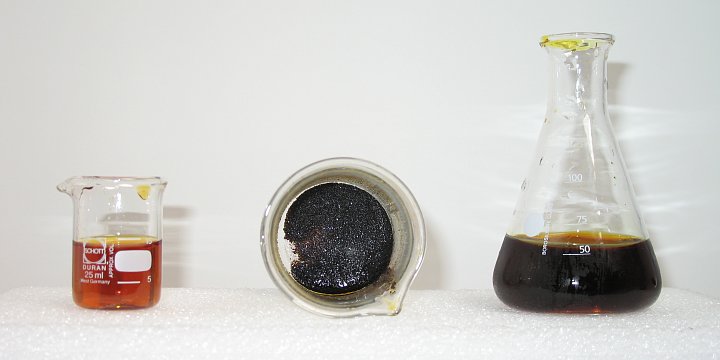
At the left, the rinse water is shown, at the right the decanted liquid and in the middle, the crystal mass can be seen, still wet.
![]() After
each rinse, try to get rid of as much as possible of the rinsing water. This can
be done by carefully but quickly moving the beaker with the crystal mass. When
this is done, it becomes more compact and water floats on top of it. Try to
decant as much as possible of the water in this way. More water can be sucked
away by sticking a clean filter paper into the crystal mass, but this is not
really necessary if the decanting is done sufficiently well. Work quickly during
this rinse/decant stage.
After
each rinse, try to get rid of as much as possible of the rinsing water. This can
be done by carefully but quickly moving the beaker with the crystal mass. When
this is done, it becomes more compact and water floats on top of it. Try to
decant as much as possible of the water in this way. More water can be sucked
away by sticking a clean filter paper into the crystal mass, but this is not
really necessary if the decanting is done sufficiently well. Work quickly during
this rinse/decant stage.
![]() After
two water rinses, rinse with ethanol. One can use 96% denatured alcohol, but
this should not be the dirty cheap crap with all kinds of dyes. Again, use
approximately 7 ml of liquid for each rinse. The first rinse with alcohol gives
a turbid yellow liquid with finely dispersed solid in the alcohol and the dark
crystal mass at the bottom. It looks as follows:
After
two water rinses, rinse with ethanol. One can use 96% denatured alcohol, but
this should not be the dirty cheap crap with all kinds of dyes. Again, use
approximately 7 ml of liquid for each rinse. The first rinse with alcohol gives
a turbid yellow liquid with finely dispersed solid in the alcohol and the dark
crystal mass at the bottom. It looks as follows:
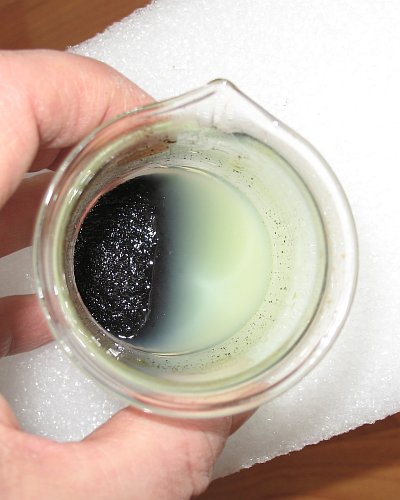
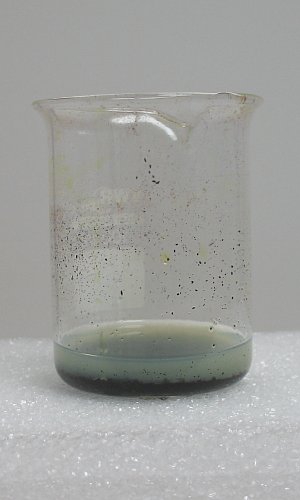
Carefully swirl the beaker with the crystals and alcohol and quickly decant the alcohol with the yellow turbidity. After the first rinse, the alcohol is really turbid and bright yellow. After the second rinse, it is as in the pictures above. After the third rinse, the alcohol is only a little cloudy and after the fourth rinse it is almost clear. One can add another rinse. Whether this is necessary or not, depends on how well the rinse liquid is decanted from the crystal mass.
![]() At this
step, one can put the crystal mass on a clean filter paper and let this paper
absorb the remaining alcohol from the last rinse and when the crystal mass is
reasonably dry then spread the crystal mass in a petri dish and let it dry while
in contact with air. If possible, however, it is better to have two additional
rinses with approximately 7 ml of diethyl ether. After both rinses, the liquid
is completely clear. After the second rinse with ether, the crystal mass must be
decanted really thoroughly and the crystal mass must be put in a petri dish.
When the dish is put on a radiator, which is warm to the touch (not hot), then
the crystal mass is dry within 30 minutes and absolutely no smell of ether or
alcohol remains.
At this
step, one can put the crystal mass on a clean filter paper and let this paper
absorb the remaining alcohol from the last rinse and when the crystal mass is
reasonably dry then spread the crystal mass in a petri dish and let it dry while
in contact with air. If possible, however, it is better to have two additional
rinses with approximately 7 ml of diethyl ether. After both rinses, the liquid
is completely clear. After the second rinse with ether, the crystal mass must be
decanted really thoroughly and the crystal mass must be put in a petri dish.
When the dish is put on a radiator, which is warm to the touch (not hot), then
the crystal mass is dry within 30 minutes and absolutely no smell of ether or
alcohol remains.
![]() The final result is a perfectly dry, non-hygroscopic
crystalline solid, which is almost black. The solid consists of many glittering
crystals. It really is dry and completely non-hygroscopic, just like potassium
dichromate. If it is somewhat sticky, or wet-looking then the final rinsing with
alcohol was not good (oily non-volatile compounds in the denatured alcohol may
cause stickiness). For this reason it is best to do two other rinses with the
very volatile diethyl ether, which assures that no non-volatile oily compounds
remain.
The final result is a perfectly dry, non-hygroscopic
crystalline solid, which is almost black. The solid consists of many glittering
crystals. It really is dry and completely non-hygroscopic, just like potassium
dichromate. If it is somewhat sticky, or wet-looking then the final rinsing with
alcohol was not good (oily non-volatile compounds in the denatured alcohol may
cause stickiness). For this reason it is best to do two other rinses with the
very volatile diethyl ether, which assures that no non-volatile oily compounds
remain.

Finally, the material is packaged in a clean glass bottle, which first can be tared on an analytical scale.
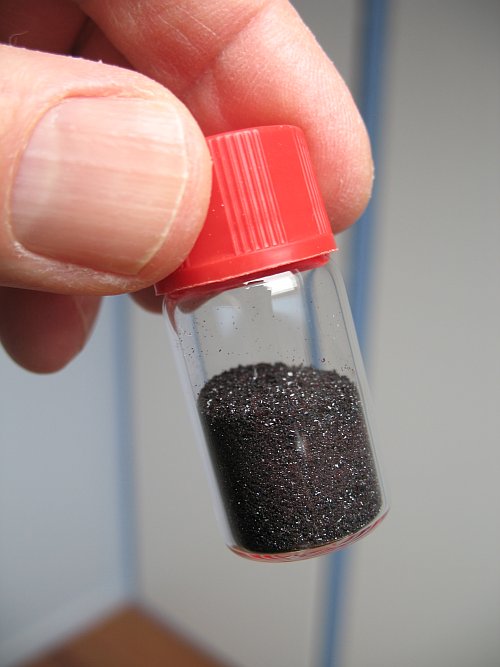
Total yield of solid is just over 7 grams (starting from 5 grams of potassium dichromate). This means that the yield is approximately 70% from theory (explanation follows below, at the end of this page).

![]()
Some properties of potassium tetraperoxochromate(V)
The salt is only sparingly soluble in water. It dissolves very slowly, giving clear brown/red solutions. Below follow two pictures of such solutions. At the left, a very dilute solution is shown, with just a few tiny crystals, added to the water. At the right, a somewhat more concentrated solution is shown.
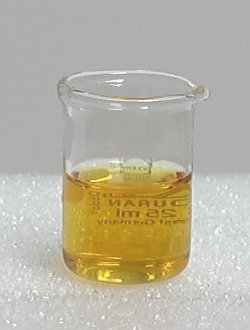
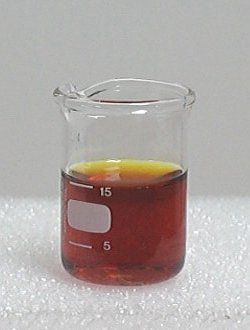
When such solutions are acidified, then at once, the peroxochromate ion is converted to deep blue CrO5. This deep blue complex in turn quickly decomposes, giving bubbles of oxygen, and a green chromium(III) compound remains behind in solution. The two following videos show what happens if the solutions are acidified.
- acidification of dilute solution (download size appr. 300 kByte)
- acidification of more concentrated solution (download size appr. 1.7 Mbyte)
The solid is stable at room temperature and keeps indefinitely, if it is stored in a dry and clean place. When the solid is heated, then it explodes. The following video shows the heating of a very tiny amount (20 mg or so) in an old dirty somewhat wet test tube: explosion.avi (download size appr. 650 kByte). After the explosion, the test tube is filled with a yellow smoke, which mostly is K2CrO4, and a mix of oxides and peroxides of potassium, probably K2O, K2O2 and KO2.
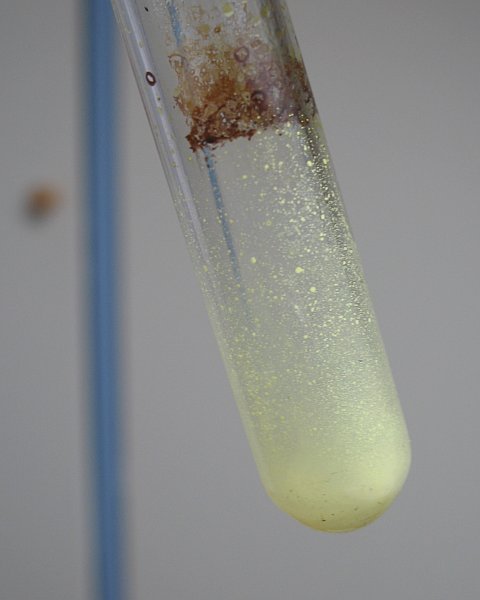
![]()
The underlying principle of this synthesis
The reaction for this synthesis is the following:
2CrO42 + 9H2O2 + 2OH → 2CrO83 + 10H2O + O2
The hydrogen peroxide in this reaction works both as source of peroxo ligands and as a reductor for reducing chromium from the +6 to the +5 oxidation state. Finding this equation is not as easy as it looks. When one simply is solving for all elements and charge, then there remains an ambiguity. In order to find the correct balanced equation, one has to assume preservation of peroxo ligands and one has to assume pure reduction of hydrogen peroxide and no simple decomposition. For each chromium atom, 4 peroxo ligands are required, hence 8 molecules of hydrogen peroxide are used for forming the peroxochromate(V) ion. For each two chromium atoms which go from oxidation state +6 to oxidation state +5, one molecule of hydrogen peroxide can be used as reductor. This makes up a total of 9 molecules of hydrogen peroxide for two chromate ions.
The ion CrO83 forms a sparingly soluble salt with potassium ions and when it is formed, it slowly forms a crystalline solid with the potassium ions, present in solution.
So, with potassium chromate and potassium hydroxide as salts, the equation would be as follows:
2K2CrO4 + 9H2O2 + 2KOH → 2K3CrO8 + 10H2O + O2
According to the equation above, one could mix 6.5 grams of potassium chromate with at least 5.2 grams of hydrogen peroxide and at least 1.9 grams of potassium hydroxide. This would give 10 grams of product if yield were 100%. In a practical synthesis, one would add 3 grams of potassium hydroxide and some excess hydrogen peroxide.
For most home chemists, however, potassium chromate is a rare chemical. Potassium dichromate can be obtained more easily. It is a common chemical in photography and as a chrome mordant. For this reason, the synthesis, described in this webpage is based on potassium dichromate. In solution, 5 grams of potassium dichromate and 1.9 grams of potassium hydroxide makes 6.6 grams of potassium chromate.
So, instead of using 6.5 grams of potassium chromate and 1.9 grams of potassium hydroxide, one can also use 5 grams of potassium dichromate and 3.8 grams of potassium hydroxide. The minimum amount of chemicals needed is
- 5 grams of potassium dichromate
- 3.8 grams of potassium hydroxide
- 5.2 grams of hydrogen peroxide
A practical synthesis requires some excess potassium hydroxide (the CrO83 ion is strongly stabilized by high pH) and some excess hydrogen peroxide, because part of it decomposes giving more oxygen gas than the equations above suggest. Suitable amounts then are
- 5 grams of potassium dichromate
- 5 grams of potassium hydroxide
- 6 grams of hydrogen peroxide
These amounts give some headroom for decomposition of hydrogen peroxide and the potassium hydroxide being less than 100% (it usually contains some water).
The solution of hydrogen peroxide must not be too concentrated. A high concentration results in exothermic decomposition and possible runaway. For this reason, the hydrogen peroxide is not added as 30% solution, but as 15% solution. This change was made after personal experience with more concentrated solutions. Higher concentration results in excessive bubbling and foaming and possible runaway. Lower concentration results in more losses, because less crystalline solid is deposited from the solution.
The net reaction from these reactants is the following:
K2Cr2O7 + 9H2O2 + 4KOH → 2K3CrO8 + 11H2O + O2
A 100% yield would give 10.1 grams of K3CrO8 when 5 grams of K2Cr2O7 is used. The synthesis, as outlined above, results in 7 grams of dry crystals. The yield is 70%, which is good enough for hobby and scientific purposes.